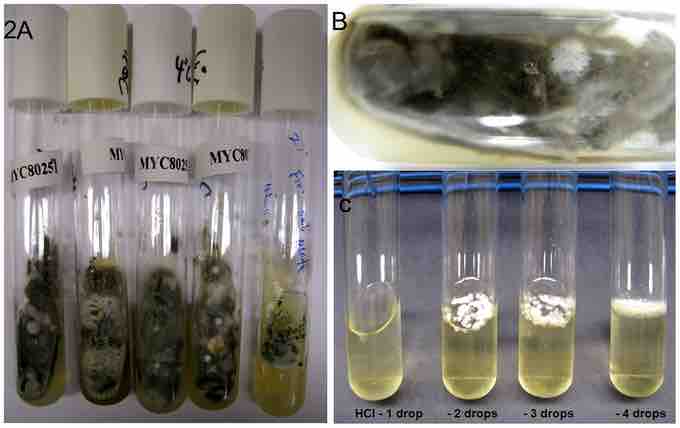Microbial cultures are foundational and basic diagnostic methods used extensively as a research tool in molecular biology. It is often essential to isolate a pure culture of microorganisms. A pure (or axenic) culture is a population of cells or multicellular organisms growing in the absence of other species or types. A pure culture may originate from a single cell or single organism, in which case the cells are genetic clones of one another. For the purpose of gelling the microbial culture, the medium of agarose gel (agar) is used. Agar is a gelatinous substance derived from seaweed. A cheap substitute for agar is guar gum, which can be used for the isolation and maintenance of thermophiles .

Selective Media
Geomyces destructans in culture from bat tissues. (A) Original culture tubes of Sabouraud agar supplemented with nine antibiotics and incubated at 4°C for six- or eight-weeks; notice the profuse growth of G. destructans strains. (B) Some fungal contamination on individual isolates was visible as depicted in the close-up of a culture tube. (C) Enrichment and recovery of pure fungal colonies by treating a culture contaminated with bacteria with hydrochloric acid.
Microbiological cultures can be grown in petri dishes of differing sizes that have a thin layer of agar-based growth medium. Once the growth medium in the petri dish is inoculated with the desired bacteria, the plates are incubated at the best temperature for the growing of the selected bacteria (for example, usually at 37 degrees Celsius for cultures from humans or animals or lower for environmental cultures). Another method of bacterial culture is liquid culture, in which the desired bacteria are suspended in liquid broth, a nutrient medium. These are ideal for preparation of an antimicrobial assay. The experimenter would inoculate liquid broth with bacteria and let it grow overnight (they may use a shaker for uniform growth). Then they would take aliquots of the sample to test for the antimicrobial activity of a specific drug or protein (antimicrobial peptides). As an alternative, the microbiologist may decide to use static liquid cultures. These cultures are not shaken and they provide the microbes with an oxygen gradient.